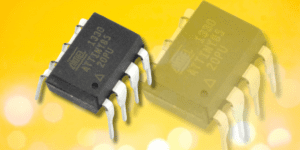Spis treści:
Solid-state relays are extremely useful modules that are used in various fields of electronics. It is worth learning about their construction, principle of operation and parameters.
SSR relay vs. electromagnetic relay
Password “relay” most people associate with an electromechanical switching component, made on the basis of an electromagnet and a set of fixed and movable contacts. Traditional relays electromagnetic relays have a number of important advantages, which include. very low contact resistance, thanks to which the circuits being connected are controlled in an almost lossless manner. The low cost of standard relay models, as well as their ease of control, influence the enduring popularity of these components in industrial automation equipment, building installations, measuring and medical equipment, automotive applications, military apparatus and countless other areas of technology. Unfortunately – the biggest drawback of relays is limited contact life, especially under load conditions close to the maximum allowable current/voltage for the contacts of a given model.
In situations where frequent switching or long-term trouble-free operation is required, so-called “solid-state relays” come to the rescue. solid-state relays (Solid State Relay, or SSR for short). They are completely devoid of any moving parts – the control of the load circuit is carried out solely by electronic means, so the SSR modules achieve incredibly high durability and reliability, even under truly impressive loads.
Not only that – solid-state relays offer a much higher switching speed compared to classic relays. The delay time between a change in the control signal and the response of the output keying circuits ranks at a few milliseconds or less. SSR relays are also better suited for the control of inductive loads, as they allow to reduce the level of interference emissions produced when switching loads.
Structure of the SSR relay
Input of a typical SSR relay contains galvanic isolation, provided by an optocoupler or an optotriac. The task of the optoisolator is to separate the input circuit from the output circuit to protect both the control system (e.g. microcontroller) from uncontrolled current flows or too high potentials, and the users – from the consequences of life-threatening electric shocks.
On the “secondary” side of the galvanic barrier are the actual keying elements, incorporated in series in the load supply circuit. The following are most often used as keys triac or paired MOSFET transistors, although you can also find designs based on thyristors or even modern high-power IGBT transistors. An important part of the SSR relay is the quench circuits, used to suppress voltage pulses generated when controlling loads of an inductive nature. SSRs can also include additional protection circuits, such as surge protectors or temperature monitoring circuits. Due to the heat release of high-current loaded semiconductor components, heat sinks are often used in practice to improve the cooling conditions of the relay – medium- and high-power SSR enclosures are therefore structurally prepared for the installation of external heat sinks.
The most important types of SSR relays
The advantage of electronic load switching is the ability to flexibly adapt the way the energy consumer is controlled to the needs of a particular application. Interestingly, in the case of solid-state relays, we have a choice of three main types of these components, which differ in their behavior in response to a control signal.
- Instant On relays are controlled completely asynchronously with respect to the line voltage and current waveforms in the output circuit. This means that the relay is switched on almost immediately when the appropriate signal is given to the control input, and it also takes just as short a time to switch it off when the input voltage disappears.
- Relays with zero-voltage switching, after receiving a control signal, wait until the nearest “zero” – that is, the moment when the sine wave of the mains voltage passes through zero (in other words – the polarity of the voltage in the load circuit changes) and only then activate the output element (such as a triac). This allows large resistive loads (e.g., heaters) to be safely, “softly” switched, without the risk of large current surges.
- Relays with switching at the peak of the mains voltage operate analogously to those described previously, but the difference is that the output is switched on when the voltage of the load circuit reaches its maximum value. This mode of operation is useful when controlling inductive loads, since – due to the phase shift – the voltage peak corresponds (approximately) to zero current.
Example parameters
The most important catalog parameters SSR relays
we will analyze on the example of one available in our store Fotek brand modules – SSR-75 DA. The relay is suitable for mains load operation, with an AC voltage range extending as low as 24 V AC and up to 380 V AC. The rated current that the module is capable of handling is as much as 75 amps, while the response time does not exceed 10 ms, which is one half-period of voltage at 50 Hz. Importantly, the relay can be driven by low-voltage digital circuits – the minimum input voltage needed to trigger the output is only 3 V. The upper limit of the control signal is 32 V, so that the relay can also work in systems supplied with 12V or 24 V – a good example would be here PLCs. The entire module measures 63 x 45 x 23 mm and can be bolted to the heatsink with two screws spaced 48 mm apart.
How useful was this post?
Click on a star to rate it!
Average rating 5 / 5. Vote count: 1
No votes so far! Be the first to rate this post.







